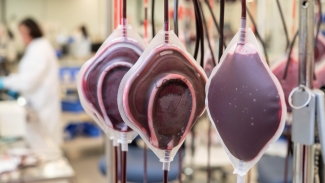Despite the critical and increasing demand for platelets within the health-care system, they remain the most commonly discarded blood component in Canada. Why are they so frequently wasted? Improper storage outside of the hospital blood bank is the main reason that platelets get discarded before they’ve reached the end of their 7-day shelf life. The goal of a study conducted by our team at the University of Toronto QUEST research program and supported by Canadian Blood Services was to decrease platelet discards by introducing use of a Platelet Transport Bag.
To understand why platelet storage errors are so common, it’s important to be familiar with their strict storage requirements: they may be stored for up to 7 days at 20-24°C with continuous gentle agitation. When platelets must be transported, they can be stored at 20-24°C without agitation for 24 hours. And once a platelet unit is issued for use, it can be only be outside of a controlled temperature environment for, at most, 60 minutes.
Most of the platelet wastage happens after platelets are issued from the hospital blood bank and transported to the patient bedside, but are not required and then returned to the blood bank. In these situations, nearly all platelets issued and returned end up being discarded because they have been in an uncontrolled environment for more than 60 minutes.
Our QUEST team developed the Platelet Transport Bag to provide a controlled temperature during transit to and from the patient bedside. Testing showed that the insulated bags could successfully maintain the temperature of platelets between 20-24°C up to a maximum of 4 hours in areas with different ambient temperatures. The QUEST research team worked with 16 hospitals across Canada to implement the Platelet Transport Bag and also provided training on platelet handling to key staff, such as those in the trauma room, emergency department, operating room, and the intensive care unit.
The findings, published in the journal Transfusion, were at first a bit disappointing: they showed that platelet discard rates did not decrease across all the participating hospitals when Platelet Transport Bags were used (following a 1-year implementation period from February 2018 to February 2019). However, after conducting an audit of the factors that contributed to platelet discards, it was clear that some events that contributed to waste were avoidable. Some of these reasons included failure to return a platelet unit within 60 minutes (when stored outside of a Platelet Transport Bag), removal of a platelet unit from the Platelet Transport Bag, placement of platelet units in red blood cell coolers, and low temperature on return to blood bank (when stored outside of a Platelet Transport Bag). Although the Platelet Transport Bags didn’t appear to decrease waste, many participating sites found them to be an effective tool and decided to continue using these bags as standard practice.
Moving forward, we will build on these findings to redesign the intervention, increase the sample size, and apply revised strategies, such as an interactive educational plan and a consistent and re-occurring audit across participating sites for wastage accountability. Collaboratively, these practices may lead to decreased discards so we can continue to meet the growing patient demand for platelets.
Canadian Blood Services – Driving world-class innovation
Through discovery, development and applied research, Canadian Blood Services drives world-class innovation in blood transfusion, cellular therapy and transplantation—bringing clarity and insight to an increasingly complex healthcare future. Our dedicated research team and extended network of partners engage in exploratory and applied research to create new knowledge, inform and enhance best practices, contribute to the development of new services and technologies, and build capacity through training and collaboration. Find out more about our research impact.
The opinions reflected in this post are those of the author and do not necessarily reflect the opinions of Canadian Blood Services nor do they reflect the views of Health Canada or any other funding agency.
Related blog posts
People with a low platelet blood count, such as cancer patients receiving chemotherapy, can receive a platelet transfusion to boost their platelet count. But what is the best approach to platelet transfusion? In its latest publication, the International Collaboration for Transfusion Medicine Guidelines examines the quality of seven platelet transfusion guidelines.
A study conducted by researchers in the University of Toronto QUEST program, a research collaborative supported by Canadian Blood Services, looked at what can be done to reduce the number of inappropriate red blood cell transfusions in hospitals.

